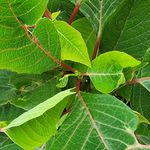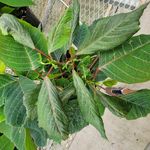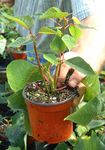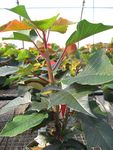Poinsettia Leaf and Stem Abnormalities - e-GRO
←
→
Page content transcription
If your browser does not render page correctly, please read the page content below
Roberto G. Lopez Heidi Lindberg
rglopez@msu.edu wollaege@msu.edu
Volume 10 Number 36 October 2021
Poinsettia Leaf and Stem 2021 Sponsors
Abnormalities
Given that poinsettias are propagated during the hottest months
of the year and have a very long production time, they are
prone to several pathogens, pests, and physiological disorders.
Occasionally, greenhouse growers observe irregularities on the
leaves or stems of their crop that are not caused by insects or
diseases. Environmental factors during both propagation and
production, such as drought stress, exposure to high light or
temperatures, or changes in relative humidity, can all cause
poinsettia leaf abnormalities, distortion, crippling, or puckering.
These issues are often the most difficult to diagnose as you
cannot isolate the problem in a petri dish or visually observe an
insect or pathogen. Recent reports of leaf abnormalities align
with the traditional occurrence of these symptoms that often
occur from mid-September to early October.
Poinsettia leaf distortions (Figure 1) often occur on young or
immature leaves and are believed to be caused by many factors.
Reprint with permission from the
author(s) of this e-GRO Alert.
Figure 1. Leaf Distortion and irregular meristem growth likely caused
by extreme environmental factors or overhead fertility (Photo:
Anonymous Grower).
www.e-gro.org
1e-GRO Alert - 2021 Poinsettia Leaf and Stem Abnormalities
Leaf and meristem distortions can be
caused by herbicide exposure, but if you
can rule out an exposure there are many
environmental and cultural factors that
can lead to leaf distortions. Physical
damage during pinching, ruptured cells and
latex residue can cause the expanding leaf
to become distorted. Therefore, care
should be taken to avoid latex from
dripping onto the plant during pinching.
Always remember to wash off fertilizer
residue from foliage, especially young Figure 2. Overhead fertilizer containing phosphorus
leaves if you overhead fertigate your crop during propagation can cause leathery, wrinkled and
with fertilizers containing phosphorus distorted leaves.
during propagation (Figure 2) or
production. Leaf distortion can also result
from dramatic temperature and humidity
changes, high greenhouse temperatures
after transplant as plants are moved from
propagation to production. Typically, as
plants grow, mature leaves will cover the
distorted or damaged young leaves and not
influence the marketability of the crop.
Leaf Curl from Desiccation
Leaf curl with browning/necrotic tissue are
often a symptom of heat stress, leaf scorch
Figure 3. Leaf curl with browning/necrotic tissue are
or desiccation (Figure 3). The water stress often a symptom of heat stress, leaf scorch from
symptoms on poinsettia typically occurs on excessively high light or water stress and on
leaves in the middle portion of the plant or poinsettia (Photo: Roberto Lopez).
leaf. As your crop is actively growing when
greenhouse temperatures and light levels
are high, it is essential that you provide
adequate irrigation to avoid extreme
conditions (excessively dry or wet) that
can result in leaf desiccation, poor growth,
and disease susceptibility. Excessively dry
plants should not be irrigated with cold
water as uptake and transport by the roots
can be inhibited for a short interval. Under
extended drought stress, lower leaves will
turn yellow, brown, and eventually senesce
(Figure 4). Figure 4. Brown leaves and desiccation on the middle
of the plant are symptoms of drought and heat stress
on poinsettia (Photo: Royal Heins).
www.e-gro.org 2e-GRO Alert - 2021 Poinsettia Leaf and Stem Abnormalities
Figure 5. Excessive stretch of stems and poor branching Figure 6. Lateral branches never develop due to
can be a result of growing plants pot tight (not spaced heat stress (blind shoots). Photo: Royal Heins
apart) or from pinching plants too late. (Photos: Royal
Heins and Roberto Lopez).
Excessive Stretch and Poor Branching
Given that bracts provide the aesthetic beauty of the
crop, excessive stretch and poor branching can
significantly reduce crop quality. Poor branching is a
disorder that results in uneven lateral shoot breaking
(top breaks are larger and stronger than bottom breaks;
Figure 7) or lack of breaks due to blind shoots (Figure 6).
Sometimes growers wait too long to pinch their plants
resulting in poor and uneven branching. In such
instances, plants become tall and lateral shoots emerge
before pinch and break unevenly after pinch. Therefore,
it is critical that plants are pinched before breaks form Figure 7. Removal of 1 or 2 “Flag
to promote uniform branching. For early branching leaves will help promote uniform
branching and increase light to those
cultivars, the maximum recommended time from branches. Photo: Roberto Lopez.
planting to pinch is 12 to 14 days to minimize this
disorder. For all other cultivars, plants should be pinched when the roots reach the
edge of the container or 4 to 5 weeks after direct sticking into the final container. In
general, the number of nodes remaining should match the finish container size. For
example, 4 to 5 nodes for a 4-inch, 5 to 6 nodes for a 6-inch, and 7 to 8 nodes for an 8-
inch container. If too many nodes are left, this will encourage weak, horizontal growth.
Lastly, it is recommended to remove 1 to 2 “flag” leaves just below the pinch, leaving
only the bottom three or four leaves to increase light penetration to the developing
breaks, promoting stronger and more uniform branching. Removal of these immature
leaves improves uniformity of lateral shoot development, as immature leaves
contribute to apical dominance until the leaf is mature. For crops that receive a very
soft pinch, it is critical to remove the upper leaves as apical dominance might not be
overcome with just the pinch. This will help slow the growth of top developing breaks.
www.e-gro.org 3e-GRO Alert - 2021 Poinsettia Leaf and Stem Abnormalities
Mechanical Injury
This type of injury can occur at any point
during production. However, it is most
typically seen when plants are individually
handled (spaced, sleeved, and shipped). In
addition, if your crop is hand watered,
water nozzles can also cause mechanical
injury. Symptoms include the wilting of
the lower branch(s) that were damaged
during the handling (Figure 8). Careful
handling, plant rings or supports can be an
insurance against mechanical injury.
Take-home
The first to 3 to 4 weeks after transplant
are critical for the success of your crop.
When rooted cuttings are transplanted
and placed in very hot greenhouses (>90
Figure 8. Mechanical injury to a
°F), plants do not branch well and branch caused by a watering wand.
develop leathery, hard, strapped-shaped
leaves several weeks later. If it is not
possible to keep greenhouse temperatures
below 90 °F, provide shade. If possible,
place plants as close to cooling pads and
mist them during the hottest parts of the
day to try to reduce plant temperature.
Also remember that cool temperatures
will slow overall growth, while high
temperatures can cause heat delay, leaf
edge burn and foliage distortion. Lastly,
improper application of insecticides can
also mimic some of the physiological
disorders discussed in this article (Figure
9).
Figure 9. Phytotoxicity caused by an improper
insecticide application (Photo: Royal Heins).
www.e-gro.org 4e-GRO Alert - 2021
e-GRO Alert Cooperating Universities
www.e-gro.org
CONTRIBUTORS
Dr. Nora Catlin
Floriculture Specialist
Cornell Cooperative Extension
Suffolk County
nora.catlin@cornell.edu
Dr. Chris Currey
Assistant Professor of Floriculture
Iowa State University
ccurrey@iastate.edu
Dr. Ryan Dickson
Greenhouse Horticulture and
Controlled-Environment Agriculture
University of Arkansas
ryand@uark.edu
Thomas Ford
Commercial Horticulture Educator
Penn State Extension
tgf2@psu.edu
Dan Gilrein
Entomology Specialist
Cornell Cooperative Extension
Suffolk County
dog1@cornell.edu
Dr. Joyce Latimer
Floriculture Extension & Research
Virginia Tech
jlatime@vt.edu
Heidi Lindberg
Floriculture Extension Educator
Michigan State University
wolleage@anr.msu.edu
Dr. Roberto Lopez
Floriculture Extension & Research
Michigan State University
rglopez@msu.edu
Dr. Neil Mattson
Greenhouse Research & Extension
Cornell University
neil.mattson@cornell.edu
Dr. W. Garrett Owen
Greenhouse Extension & Research
University of Kentucky
wgowen@uky.edu
Dr. Rosa E. Raudales
Greenhouse Extension Specialist
University of Connecticut
rosa.raudales@uconn.edu
In cooperation with our local and state greenhouse organizations
Dr. Beth Scheckelhoff
Extension Educator – GreenhouseSystems
The Ohio State University
scheckelhoff.11@osu.edu
Dr. Ariana Torres-Bravo
Horticulture/ Ag. Economics
Purdue University
torres2@purdue.edu
Dr. Brian Whipker
Floriculture Extension & Research
NC State University
bwhipker@ncsu.edu
Dr. Jean Williams-Woodward
Ornamental Extension Plant Pathologist
University of Georgia
jwoodwar@uga.edu
Copyright © 2021
Where trade names, proprietary products, or specific
equipment are listed, no discrimination is intended and
no endorsement, guarantee or warranty is implied by
the authors, universities or associations.
www.e-gro.org 5You can also read



























































